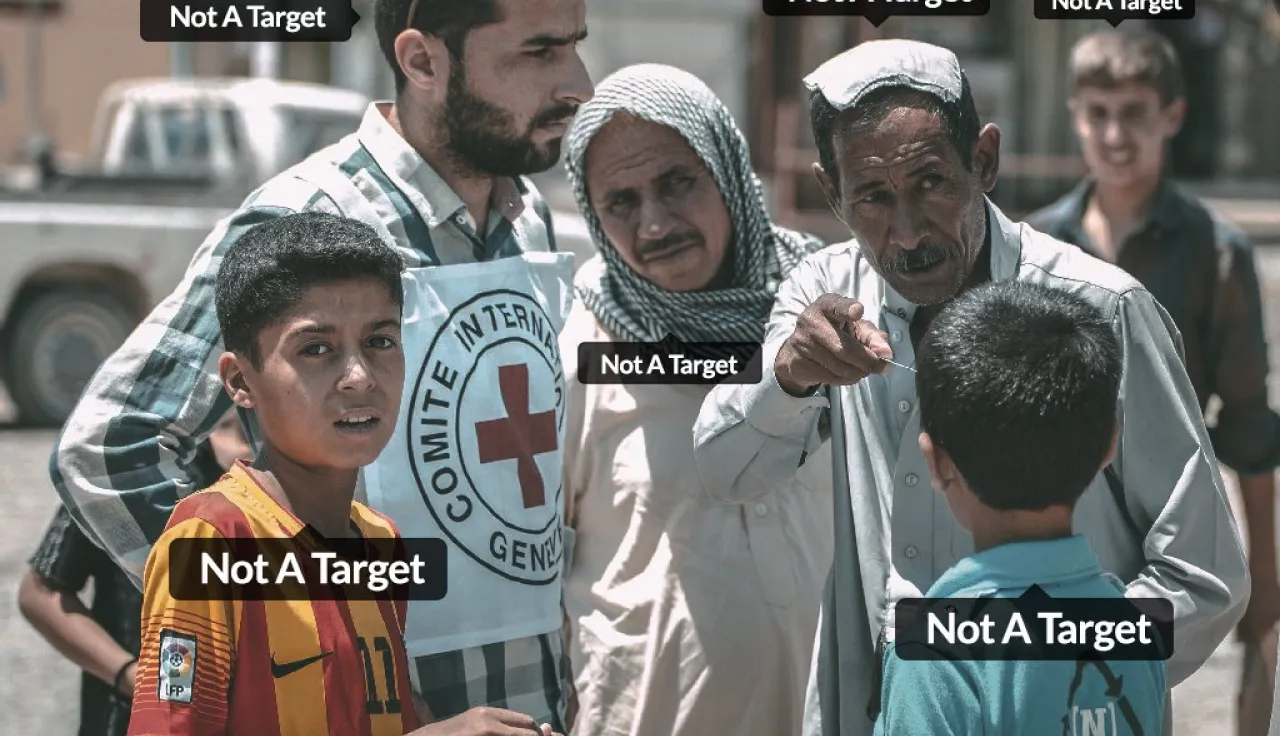What is the difference between IHL and human rights law?

Extract from ICRC publication "International humanitarian law: answers to your questions"
WHAT IS INTERNATIONAL HUMAN RIGHTS LAW?
Human rights law is a set of international rules, established by treaty or custom, on the basis of which individuals and groups can expect and/or claim certain rights that must be respected and protected by their States. The body of international human rights standards also contains numerous non-treaty-based principles and guidelines ('soft law').
The main treaties of human rights law are given below:
a) Universal instruments
- Convention on the Prevention and Punishment of the Crime of Genocide (1948)
- Convention on the Elimination of All Forms of Racial Discrimination (1965)
- International Covenant on Civil and Political Rights (1966)
- International Covenant on Economic, Social and Cultural Rights (1966)
- Convention on the Elimination of All Forms of Discrimination against Women (1979)
- Convention against Torture and Other Cruel, Inhuman or Degrading Treatment or Punishment (1984)
- Convention on the Rights of the Child (1989)
- International Convention on the Protection of the Rights of All Migrant Workers and Members of their Families (1999)
- International Convention for the Protection of All Persons from Enforced Disappearance (2006)
- Convention on the Rights of Persons with Disabilities (2006)
b) Regional instruments
- European Convention on Human Rights (1950)
- American Convention on Human Rights (1969)
- African Charter on Human and Peoples' Rights (1981).
These treaties are supervised by human rights bodies, such as the Human Rights Committee for the International Covenant on Civil and Political Rights and the European Court for Human Rights for the European Convention on Human Rights.
While IHL and human rights law have developed in their separate ways, some human rights treaties include provisions that come from IHL: for instance, the Convention on the Rights of the Child and its Optional Protocol on the involvement of children in armed conflict, and the Convention on Enforced Disappearance.
IHL and international human rights law are complementary bodies of international law that share some of the same aims. Both IHL and human rights law strive to protect the lives, the health and the dignity of individuals, albeit from different angles – which is why, while very different in formulation, the essence of some of the rules is similar. For example, both IHL and human rights law prohibit torture or cruel treatment, prescribe basic rights for persons subject to criminal process, prohibit discrimination, contain provisions for the protection of women and children, and regulate aspects of the right to food and health. There are however important differences between them: their origins, the scope of their application, the bodies that implement them, and so on.
Origins
IHL, the origins of which are ancient, was codified in the second half of the 19th century, under the influence of Henry Dunant, the founding father of the International Committee of the Red Cross. (See Question 6.) Human rights law is a more recent body of law: it had its origins in certain national human rights declarations influenced by the ideas of the Enlightenment (such as the United States Declaration of Independence in 1776 and the French Declaration of the Rights of Man and of the Citizen in 1789). It was only after the Second World War that human rights law emerged, under the auspices of the United Nations, as a branch of international law. The Universal Declaration of Human Rights of 1948 first defined human rights law at the international level in a non-binding General Assembly resolution. It was only in 1966 that this Declaration was translated into universal human rights treaties: the International Covenant on Civil and Political Rights and the International Covenant on Economic, Social and Cultural Rights, both of 1966. (See box.)
Temporal scope of application
While IHL applies exclusively in armed conflict (see Question 5), human rights law applies, in principle, at all times, i.e. in peacetime and during armed conflict. However, unlike IHL, some human rights treaties permit governments to derogate from certain obligations during public emergencies that threaten the life of the nation. Derogation must, however, be necessary and proportional to the crisis, must not be introduced on a discriminatory basis and must not contravene other rules of international law – including provisions of IHL. Certain human rights can never be derogated from: among them, the right to life, the prohibition against torture or cruel, inhuman or degrading treatment or punishment, the prohibition against slavery and servitude and the prohibition against retroactive criminal laws.
Geographical scope of application
Another major difference between IHL and human rights law is their extraterritorial reach. That IHL governing international armed conflicts applies extraterritorially is not a subject of controversy, given that its purpose is to regulate the conduct of one or more States involved in an armed conflict on the territory of another. The same reasoning applies in non-international armed conflicts with an extraterritorial element: the parties to such conflicts cannot be absolved of their IHL obligations when the conflict reaches beyond the territory of a single State. Despite the views of a few important dissenters, it is widely accepted that human rights law applies extraterritorially based, inter alia, on decisions by regional and international courts. The precise extent of such application, however, is yet to be determined. Human rights bodies generally admit the extraterritorial application of human rights law when a State exercises control over a territory (e.g. occupation) or a person (e.g. detention). Human rights case law is unsettled, however, on the extraterritorial application of human rights norms governing the use of force.
Personal scope of application
IHL aims to protect persons who are not or are no longer taking direct part in hostilities. It protects civilians and combatants hors de combat, such as the wounded, the sick and the shipwrecked or prisoners of war.
(See Question 7.) Human rights law, developed primarily for peacetime, applies to all persons within the jurisdiction of a State. Unlike IHL, it does not distinguish between combatants and civilians or provide for categories of 'protected person'.
Parties bound by IHL and human rights law
IHL binds all parties to an armed conflict and thus establishes an equality of rights and obligations between the State and the non-State side for the benefit of everyone who may be affected by their conduct (an essentially 'horizontal' relationship). (See Question 8.) Human rights law explicitly governs the relationship between a State and persons who are on its territory and/or subject to its jurisdiction (an essentially 'vertical' relationship), laying out the obligations of States vis à vis individuals across a wide spectrum of conduct. Thus, human rights law binds only States, as evidenced by the fact that human rights treaties and other sources of human rights standards do not create legal obligations for non-State armed groups. The reason for this is that most groups of this kind are unable to comply with the full range of obligations under human rights law because, unlike governments, they cannot carry out the functions on which the implementation of human rights norms is premised. There is a notable exception to this generalization about non-State armed groups: those cases in which a group, usually by virtue of stable control of territory, has the ability to act like a State authority and where its human rights responsibilities may therefore be recognized de facto.
Substantive scope of application
IHL and human rights law share common substantive rules (such as the prohibition of torture), but they also contain very different provisions. IHL deals with many issues that are outside the purview of human rights law, such as the status of 'combatants' and 'prisoners of war', the protection of the red cross and red crescent emblems and the legality of specific kinds of weapon. Similarly, human rights law deals with aspects of life that are not regulated by IHL, such as the freedom of the press, the right to assembly, to vote, to strike, and other matters. Furthermore, there are areas that are governed by both IHL and human rights law, but in different – and sometimes contradictory – ways. This is especially the case for the use of force and detention.
- Regarding the use of force, IHL rules on the conduct of hostilities recognize that the use of lethal force is inherent to waging war. This is because the ultimate aim of military operations is to prevail over the enemy's armed forces. Parties to an armed conflict are thus permitted, or at least are not legally barred from, attacking each other's military objectives, including enemy personnel. Violence directed against those targets is not prohibited 40 by IHL, regardless of whether it is inflicted by a State or a non-State party to an armed conflict. Acts of violence against civilians and civilian objects – as well as indiscriminate attacks – are, by contrast, unlawful because one of the main purposes of IHL is to spare civilians and civilian objects the effects of hostilities; and, under IHL, precautions must be taken in order to minimize civilian losses. (See Question 11.) Human rights law was conceived to protect persons from abuse by the State; it regulates, not the conduct of hostilities between parties to a conflict, but the manner in which force may be used in law enforcement. Law enforcement is predicated upon a 'capture-rather-than-kill' approach: the use of force must be the last resort for protecting life, when other means are ineffective or without promise of achieving the intended result, and must be strictly proportionate to the legitimate aim to be achieved (e.g. to prevent crime, to effect or assist in the lawful arrest of offenders or suspected offenders, and to maintain public order and security).
- Concerning detention, while both IHL and human rights law provide for rules on the humane treatment of detainees, on detention conditions and on fair trial rights, differences emerge when it comes to procedural safeguards in internment, i.e. the non-criminal detention of a person based on the seriousness of the threat that his or her activity poses to the security of the detaining authority. Internment is not prohibited during armed conflict and, in general, a judicial review of the lawfulness of the detention is not required under IHL. (See Question 10.) Outside armed conflict, noncriminal (i.e. administrative) detention is highly unusual. In the vast majority of cases, people are deprived of their liberty because they are suspected of having committed a criminal offence. The International Covenant on Civil and Political Rights guarantees the right to liberty of person and provides that every individual who has been detained, for whatever reason, has the right to judicial review of the lawfulness of his or her detention. This area of human rights law is based on the assumption that the courts are functioning, that the judicial system is capable of absorbing all persons arrested at any given time regardless of their numbers, that legal counsel is available, that law enforcement officials have the capacity to perform their tasks, etc. Circumstances are very different during armed conflict, which is reflected in the provisions of IHL.
The interplay of IHL and human rights rules governing the use of force and procedural safeguards for internment, at least in international armed conflicts, must be resolved by reference to the lex specialis, that is the provisions of IHL that were specifically designed to deal with those two areas. (See box.)
INTERPLAY OF IHL AND HUMAN RIGHTS LAW
The interplay of IHL and human rights law remains the subject of much legal attention, particularly because of its consequences for the conduct of military operations. In its very first statement on the application of human rights in situations of armed conflict, the 1996 Advisory Opinion on the Legality of the Threat or Use of Nuclear Weapons, the International Court of Justice observed that the protection provided by the International Covenant on Civil and Political Rights did not cease in times of war and that, in principle, the right not to be arbitrarily deprived of one's life applied also in hostilities. The Court added that what constituted arbitrary deprivation of life had to be determined by the applicable lex specialis, namely, the law applicable in armed conflict, which is designed to regulate the conduct of hostilities.
This statement has generally been interpreted as settling the issue of the interplay of IHL and human rights law and as implying that human rights law, deemed to apply at all times, constitutes the lex generalis, while IHL, whose application is triggered by the occurrence of armed conflict, constitutes the lex specialis. In other words, when human rights law and IHL are in conflict, the latter is deemed to prevail, since it was conceived specifically to deal with armed conflict.
While the meaning and even the utility of the doctrine of lex specialis have been called into question, there is a general acceptance of its indispensability for determining the interplay of IHL and human rights law. Although, generally speaking, these two branches of international law are complementary, the notion of complementarity cannot resolve the intricate legal issues of interplay that sometimes arise. In some instance, IHL and human rights rules might produce conflicting results when applied to the same facts because they reflect the different circumstances for which they were primarily developed.



